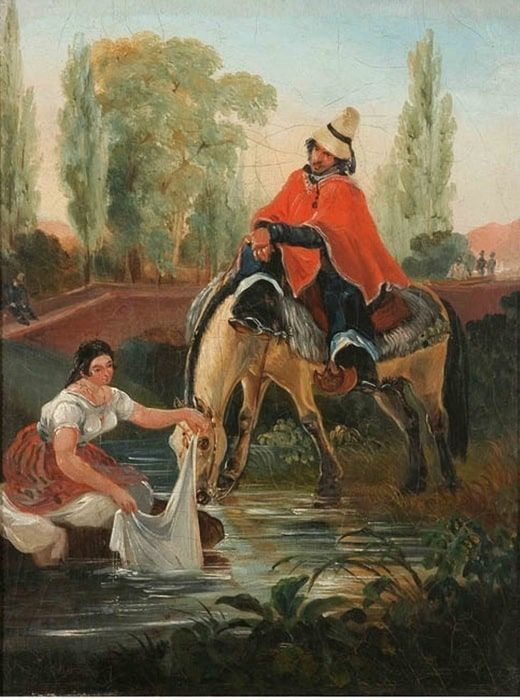Chilean novel rediscovers Rugendas, the painter in love with Latin America
When Chilean writer Carlos Franz read a biography of Johann Moritz Rugendas more than 20 years ago, he was captivated by the story of this German artist Rugendas.

A 19th-century German painter, his clandestine love of a Chilean aristocrat and his dispute with Charles Darwin marks the plot of the award-winning novel that Chilean Carlos Franz is presenting in Germany. When Chilean writer Carlos Franz read a biography of Johann Moritz Rugendas more than 20 years ago, he was captivated by the story of this German artist who portrayed the landscape and human types of Latin America, and his clandestine love of a married woman, 19th-century Chilean aristocrat.
Also inspired by the letters of the beloved, which the artist kept all his life and was published a century later, Franz investigated in-depth Rugendas and his passage through Chile, where he is considered almost a national artist. "The letters show a fascinating woman, cultured, sensitive, very intelligent, and in love, trapped in what was an end of the world. It was the material for a beautiful story," Franz tells DW.
Thus was born "Si te vieras con mis ojos", winner of the Biennial Prize of Novel Vargas Llosa in 2016, now published in Germany by Büchergilde Gutenberg, with translation by Lutz Kliche, under the title "Das Quartett der Liebenden". Franz is currently presenting his novel at the Frankfurt Book Fair and will continue with readings in Augsburg, the birthplace of Rugends, Munich, Nuremberg, Hamburg, and Berlin.
"Rugendas is historically described as a painter halfway between romanticism and the later stage. He originally illustrated the journeys of naturalists, portraying nature with the utmost fidelity. But I saw conflict between that scientific and romantic spirit," Franz says.
Rugendas fell in love with America after the first trip to Brazil, where he was commissioned by Baron de Langsdorff, and whose fruit was a book of prints that Alexander von Humboldt celebrated as the best representation of tropical nature ever made.
In search of freedom
The artist returned to the American continent, already surrounded by some fame and animated by Humboldt, and made his living painting portraits of notable people, to finance his pictorial interests. He toured the region and became known as to Mauricio Rugendas. He spent three years in Mexico and in 1834 he arrived in Chile, where he stayed for eight years, broadened his artistic horizons, and was the protagonist of a novel romance.
Carlos Franz recognizes that he took many liberties at the time of creating the fiction that envelops the protagonist and that includes a fourth character that enters the amorous conflict. It is about a young Charles Darwin, who would have coincided with Rugendas at that time in Chile, and who embodies the rival, also in his rationalistic scientific eagerness, from which the German artist was trying to distance himself.
"At that time, it was the painter who illustrated scientific books. But Rugendas did not want to limit himself to that, he wanted to have the freedom of creation, to capture nature, pure sensation, and his encounter with Darwin is the clash with a rational being, natural science and positivism", he stresses in dialogue with DW Lutz Kliche, translator of the novel into German.
In Chile, Rugendas' painting became freer. "He wanted to free himself from scientific obligation and capture the impression of nature as seen by the eye. Here we find pre-impressionist representations, sketches directly on the canvas, outdoor work, large brushstrokes," Franz notes.
A bridge between two worlds
Several coincidences led Lutz Kliche, who has translated Eduardo Galeano, Ernesto Cardenal, Sergio Ramirez, Gioconda Belli, and other outstanding Latin Americans, to Carlos Franz's book. One of them is that Kliche lives in Augsburg, the birthplace of Rugendas. "This is a very well written novel, it has a wonderful style; it is very important not only the argument but also the literary quality", the German translator points out.
For him, who has mostly translated Central American authors, it was a challenge to enter the landscapes of the south of the continent. "It's one of the things I'm passionate about, discovering new lands," he says. An eagerness is similar to the one that motivated Rugendas in his travels.
The translator acknowledges that Latin American literature does not currently enjoy the same interest in Germany as it did at the time of the boom, with authors such as García Márquez, Donoso, or Fuentes. "If you saw yourself with my eyes" opens a bridge and invites you to rediscover this character precisely in the year of Humboldt, to turn your gaze to those explorers attracted by nature, art, and culture.
Although Rugendas' work is present in museums in Munich and Augsburg, as well as in Mexico, Brazil and Chile, it is not as well known in America and Germany as one would expect, says Franz. This historical novel with a German protagonist is a hook for readers in his country and an opportunity to discover the art and passions of an exceptional traveler as he passes through America.
Source: Deutsche Welle




